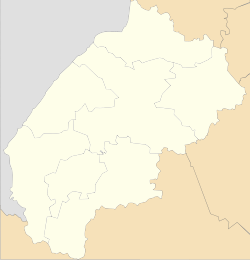Peremyshliany
Peremyshliany
Перемишляни Przemyślany | |
|---|---|
 Skyline of Peremyshliany | |
| Coordinates: 49°40′12″N 24°33′34″E / 49.67000°N 24.55944°E | |
| Country | |
| Oblast | Lviv Oblast |
| Raion | Lviv Raion |
| Hromada | Peremyshliany urban hromada |
| First mentioned | 1437 |
| Magdeburg rights | 1623 |
| Population (2022) | |
• Total | 6,415 |
| Time zone | UTC+2 (EET) |
| • Summer (DST) | UTC+3 (EEST) |
Peremyshliany (Ukrainian: Перемишляни, IPA: [peremɪˈʃlʲɑnɪ] ⓘ; Polish: Przemyślany; Yiddish: פּרעמישליאַן) is a small city in Lviv Raion, Lviv Oblast (region) of Ukraine. It hosts the administration of Peremyshliany urban hromada, one of the hromadas of Ukraine.[1] Population: 6,415 (2022 estimate).[2]
Przemyślany, as the town is called in Polish, was first mentioned as a village in 1437. Until the Partitions of Poland (1772), it was part of Poland's Ruthenian Voivodeship. In 1623, Przemyslany received Magdeburg rights. In 1772-1918, it belonged to Austrian Galicia, and in 1918, it returned to Poland. In the Second Polish Republic, it was the seat of a county in Tarnopol Voivodeship. The town had a Jewish population of 2,934 in 1900. Most of them were murdered in the Holocaust.[3]
Since 1909, the Lviv-Pidhaitsi railroad has been running through the town, which facilitated the development of trade and logging and gave impetus to the growth of the town's economy, and the development of forestry and trade began. During the First World War, two fierce Austro-Russian battles took place near Przemyślany (August 29-30, 1914 and June 29-July 2, 1915).
After the First World War, Przemyślany became part of Poland. During August-September 1920, the city was occupied by the Red Army, but after the defeat of the Red cavalry near Warsaw, 1918-1939 marked the city's re-affiliation with Poland. In 1931, the city was inhabited by 67% Poles, 20% Jews, 13% Ukrainians, and others.
Poland retained these lands until 1939. Then came the Second World War. In September 1939, the Soviets came to the city again. Soviet rule is established in the city. On 10.02. and 13.04. 1941, almost 90 people, mostly Poles, were deported from Przemyślany to Siberia.[4]
The German occupation began on July 1, 1941, when the first German soldiers entered Przemyślany. On July 4 (according to other sources, 15.07-www.jewishgen.org), in the afternoon, the main local synagogue was burned down, where an unknown number of Jews were kept.[5]
On May 22, 1943, the Nazis killed the Jewish population in Przemyślany.[6] On June 18, 1944, the Nazi troops were driven out by the Russian 16th Brigade of Colonel Vsevolod Ryvzh.

Until 18 July 2020, Peremyshliany was the administrative center of Peremyshliany Raion. The raion was abolished in July 2020, as part of the administrative reform of Ukraine, which reduced the number of raions of Lviv Oblast to seven. The area of Peremyshliany Raion was merged into Lviv Raion.[7][8]
Notable people
[edit]- Naftule Brandwein, klezmer musician
- Wojciech Filarski (1831–1898), Polish philosopher, rector of the Lwow University
- bl. Omelian Kovch (1884–1944), Ukrainian priest and martyr murdered at the Majdanek death camp.
- Wilhelm Reich (1897–1957), psychoanalyst and natural scientist was born in the village of Dobrzanica (now Dobryanichi), in the Peremyshliany district
- Adam Daniel Rotfeld (born 1938), Polish diplomat and Foreign Minister
- Baruch Steinberg (1897-1940), Rabbi killed in Katyn Massacre
- Vilunya Diskin (b. 1941), Holocaust survivor, founding member and author of Our Bodies, Ourselves[9][10]
Gallery
[edit]-
Main street of Peremyshliany
-
Local school and Taras Shevchenko monument
-
Church of St. Peter and St. Paul
-
Peremyshliany old town
-
St. Nicholas Church
References
[edit]- ^ "Перемышлянская городская громада" (in Russian). Портал об'єднаних громад України.
- ^ Чисельність наявного населення України на 1 січня 2022 [Number of Present Population of Ukraine, as of January 1, 2022] (PDF) (in Ukrainian and English). Kyiv: State Statistics Service of Ukraine. Archived (PDF) from the original on 4 July 2022.
- ^ JewishGen.org
- ^ Fert, Józef Franciszek (2020-10-21). "Bojanowski – Norwid. Projekcja spotkania". Zeszyty Naukowe KUL. 60 (4): 29–47. doi:10.31743/zn.2017.60.4.29-47. ISSN 2543-9715.
- ^ Furman, Wojciech (2019). "Trzy spotkania". Zeszyty Prasoznawcze. 62 (2): 285–288. doi:10.4467/22996362pz.19.033.10558. ISSN 2299-6362.
- ^ "Peremyshliany - History" (PDF). Państwowe Muzeum na Majdanku. Retrieved 26 December 2023.
- ^ "Про утворення та ліквідацію районів. Постанова Верховної Ради України № 807-ІХ". Голос України (in Ukrainian). 2020-07-18. Retrieved 2020-10-03.
- ^ "Нові райони: карти + склад" (in Ukrainian). Міністерство розвитку громад та територій України.
- ^ Diskin, Vilunya (December 2012). "Once Orphaned, Thrice Adopted With The Songs of the Sabbath Echoing". The Galitzianer. 19: 16–18.
- ^ Antler, Joyce (2018). Jewish Radical Feminism: Voices from the Women's Liberation Movement. New York: New York University.
Further reading
[edit]- Weiner, Miriam; Ukrainian State Archives (in cooperation with); Moldovan State Archives (in cooperation with) (1999). "Town Clips: Peremyshlany." Jewish Roots in Ukraine and Moldova: Pages from the Past and Archival Inventories . Secaucus, NJ: Miriam Weiner Routes to Roots Foundation. p. 417. ISBY 978-0-96-565081-6. OCLC 607423469.









